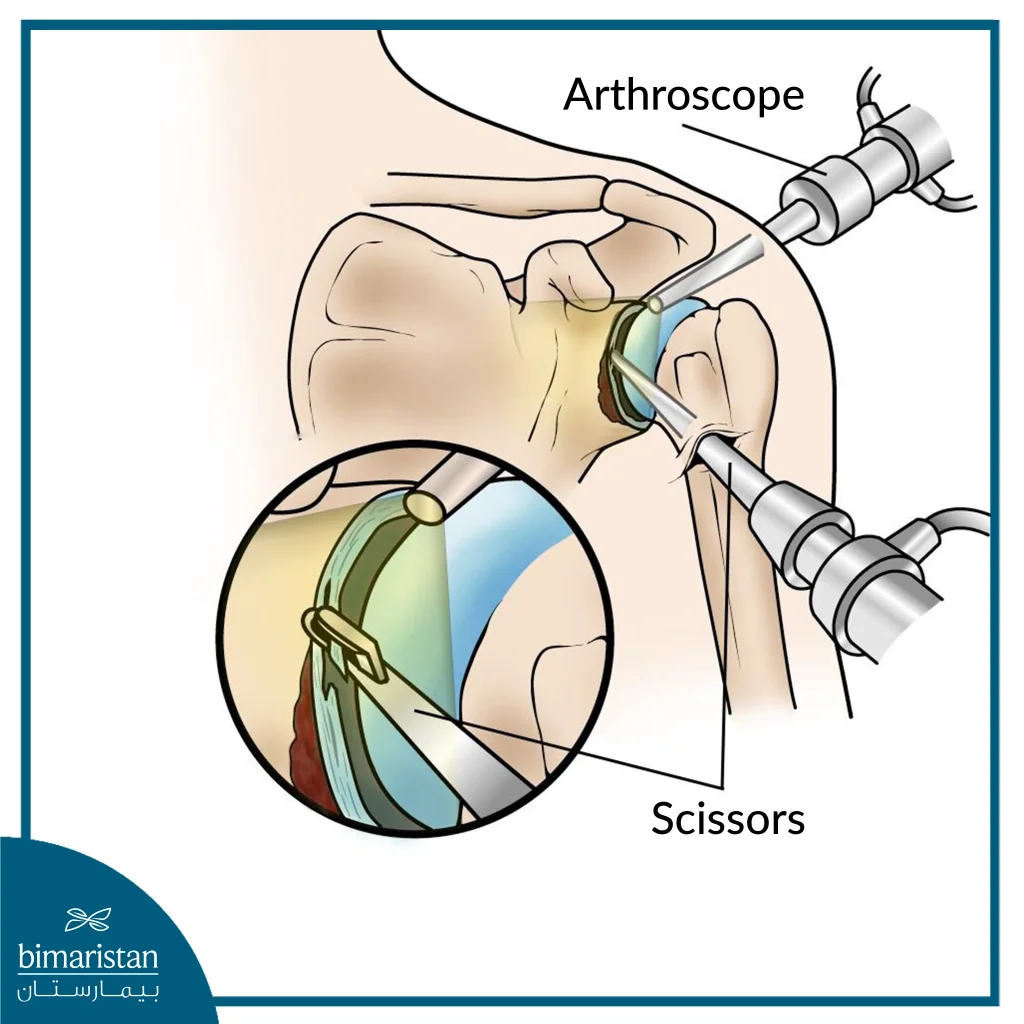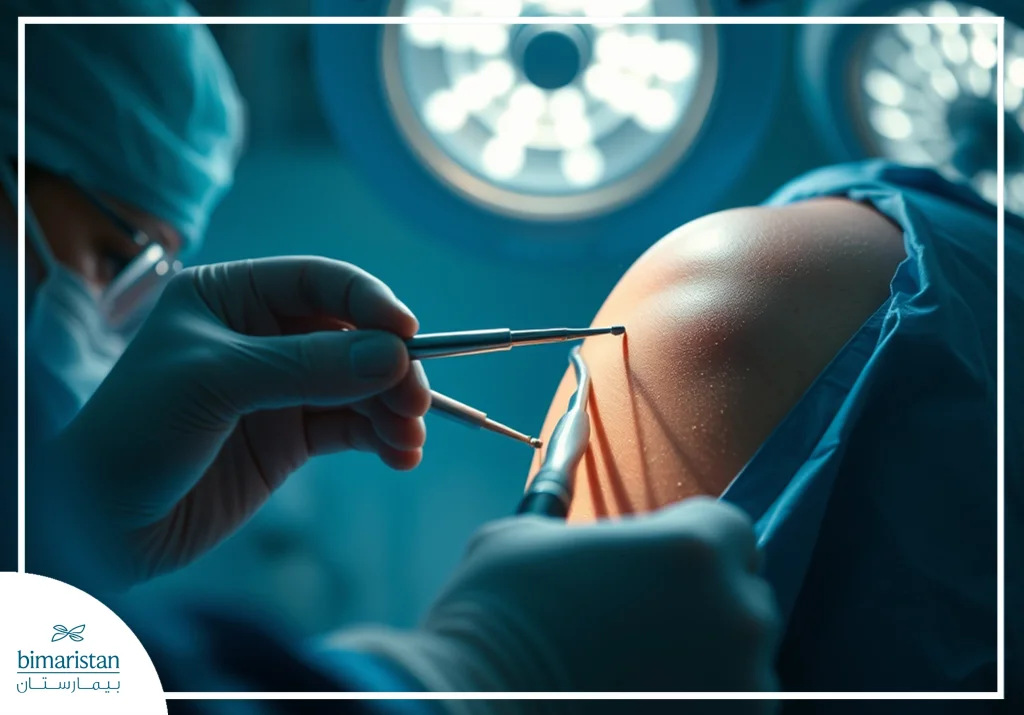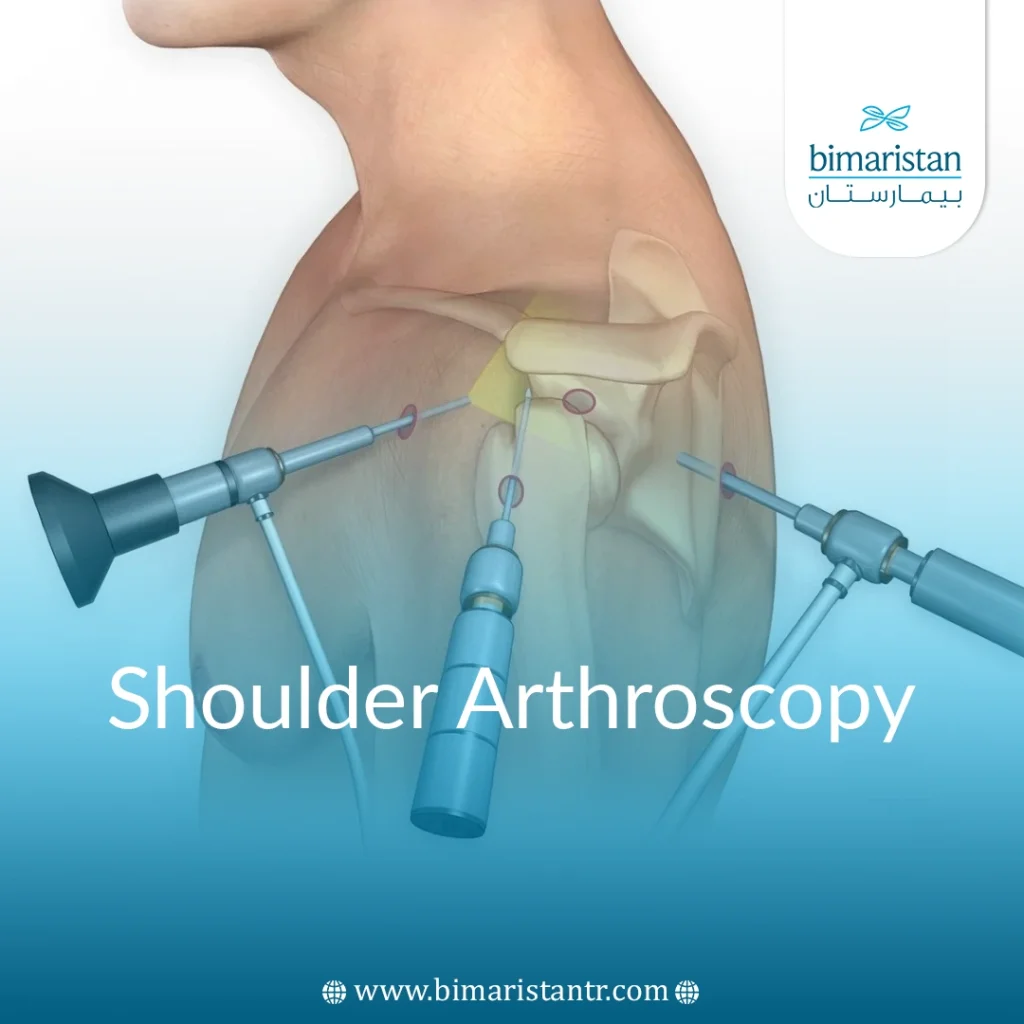Shoulder arthroscopy is a minimally invasive surgical procedure used to repair tissues in or around the shoulder joint. It is part of the arthroscopic joint surgery category and has seen significant advancements in Turkey.
What is shoulder arthroscopy?
Shoulder arthroscopy is a minimally invasive technique that allows orthopedic surgeons to access and treat the shoulder joint through very small incisions.
Shoulder arthroscopy is the second most common orthopedic procedure after knee arthroscopy. It is commonly used to treat and repair shoulder conditions, including rotator cuff tears, labral tears, degenerative arthritis, and adhesive capsulitis.
Arthroscopy offers many advantages compared to open surgery, including better visualization for surgeons, smaller incisions resulting in lower infection rates, and the potential for faster recovery and return to normal life.

What is arthroscopic joint surgery?
Arthroscopy is a term derived from the Greek words “arthro,” meaning joint, and “skopein,” meaning to look. Arthroscopic joint surgery is a modern, minimally invasive procedure used by surgeons to view the inside of the joint to diagnose and treat joint problems.
Shoulder arthroscopy is a procedure where an arthroscope (a tool containing a camera lens and fiber optic lighting system) is inserted through small incisions, no more than 0.5 cm in the patient’s skin. The arthroscope is then connected to a television screen that displays the structures inside the joint in the operating room.
What are the alternatives to shoulder arthroscopy (joint surgery) in diagnosis and treatment?
Arthroscopy allows surgeons to use magnified views to explore the internal structures of the joint to diagnose the severity or type of injury.
Initially, arthroscopy was used solely as a diagnostic tool, but now, with arthroscopic surgery, we can treat injuries that may cause joint pain or movement problems.
Computed tomography (CT) or magnetic resonance imaging (MRI) can be used to diagnose some joint diseases, but they may not show early joint injuries or the injury may never be detected due to its location.
Is arthroscopic joint surgery a suitable option for you?
If you have pain or stiffness in your knee or shoulder joint, arthroscopic surgery, also known as arthroscopic surgery, may be an option for you.
Arthroscopic surgery first became known to the public through its use in treating sports injuries suffered by athletes, such as torn meniscus in basketball players, torn runner’s knee or torn cruciate ligament during marathons, or tendinitis in the shoulder in tennis players or baseball pitchers.
Today, an estimated 80% of doctors use arthroscopy to perform surgical treatment. Arthroscopy is beneficial because it is generally easier on the patient than open surgery and requires a shorter recovery time.
Among the symptoms that patients often come to the Bimaristan Medical Center with and for which shoulder arthroscopy is useful in diagnosing or treating the condition:
- Knee pain
- Shoulder pain
- Ankle and hip pain
- Joint stiffness
- Swelling
- Difficulty in movement
- Instability (dislocation)
- Medical conditions that do not respond to conservative treatments (such as rest, ice, compression, and elevation) and do not improve with physical therapy.

To find out if shoulder arthroscopy is right for you, do not hesitate to contact us, Bimaristan Medical Center, your family in Turkey.
What are the benefits of arthroscopic joint surgery?
Compared to open surgery (which requires a large incision to access the affected area), arthroscopic surgery offers several benefits:
- Less Pain: The incision is small, and the surgical instruments are smaller, resulting in less pain.
- Reduced Cost: Knee or shoulder arthroscopy can often be performed on an outpatient basis without overnight hospital stays.
- Faster Recovery: Less scarring and a quicker recovery period compared to open surgery.
- Better Visualization: Arthroscopic joint surgery provides surgeons with magnified views and improved visualization of the internal part of the joint.
- Performed under Local Anesthesia.
- Small, Less Visible Scars.
What shoulder conditions can be treated with arthroscopy?
Shoulder arthroscopy is used to examine the shoulder joint internally to diagnose the cause of pain and to provide a diagnosis. Additionally, this procedure enables the treatment of many shoulder conditions and injuries, including:
- Rotator cuff tears
- Shoulder impingement syndrome
- Frozen shoulder
- Shoulder osteoporosis
- Biceps tendon tears at the shoulder
- Shoulder instability
- Recurrent shoulder dislocation
- Shoulder fractures
- Acromioclavicular joint dislocation
- Shoulder nerve compression
- Calcific tendonitis
Note: Arthroscopy can also be used in conjunction with open surgery in some procedures, depending on the evaluation and diagnosis of a specialist doctor. The doctor may reattach torn tendon edges, then connect the tendon to the bone with sutures or metal or plastic screws. The doctor may also clean or remove damaged or inflamed tissues. Therefore, shoulder procedures take about an hour in outpatient surgical clinics and are performed under general or local anesthesia as determined by the doctor.
Some cases cannot be treated with shoulder arthroscopy and require shoulder joint replacement.
Our website also offers information about joint surgeries and advanced surgeries in Turkey, including robotic knee joint replacement.
Shoulder arthroscopy success rate
Thanks to technological progress and modern medical techniques, shoulder arthroscopy is a highly successful surgical procedure. In general, the success rate ranges from 85% to 95% and may be higher in some cases, depending on the patient’s condition and the extent of his commitment to the doctor’s instructions after surgery.
Several factors contribute to increasing the success rate of shoulder arthroscopy, including:
- The surgeon’s experience: The more experienced the surgeon is in performing these operations, the higher the success rate.
- Accurate diagnosis: Correct diagnosis of the condition helps determine the optimal surgical approach.
- Modern techniques: The use of modern techniques and advanced tools reduces complications and increases the chances of success.
- Rehabilitation and physical therapy: Adherence to the rehabilitation and physical therapy program after the operation plays a crucial role in improving the results.
In short, shoulder arthroscopy is a successful procedure that allows patients to regain normal movement and enjoy a pain-free life, provided they adhere to the doctor’s instructions and receive the necessary care after surgery.
Complications of shoulder arthroscopy
Despite its high safety rate, this procedure carries many risks, especially in Turkey. These are often due to the anatomical position of the shoulder joint or the patient’s position during the procedure.
These complications include:
- Bleeding at the joint site or in adjacent areas.
- Inflammation or infection at the surgical site (wound) due to inadequate sterilization.
- Injury to the shoulder joint or its cartilage.
- Stiffness in the joint and incomplete joint healing.
- Allergic reaction to equipment, materials, or medications.
- Infection spreads to the chest or brain, depending on the patient’s position.
What happens after shoulder arthroscopy?
The recovery period varies from person to person, but most patients return home on the same day and take a few weeks to a few months to fully recover after surgery. Patients who have undergone shoulder arthroscopy are advised to:
- Rest the joint completely and avoid moving or lifting weights on it until it heals.
- Apply ice to the injured joint.
- Take pain relievers if severe pain persists.
- Wear a sling during the shoulder recovery period.
In addition, an orthopedic specialist may recommend physical therapy to help strengthen the shoulder joint and surrounding muscles and regain range of motion for a good outcome. Athletes may need sports rehabilitation under the supervision of a specialized physician to maintain their fitness and return to sports as soon as possible. After 15 days of shoulder arthroscopy, the stitches are removed, and the patient can bathe. However, they should not strain their shoulder because it has not fully healed yet.
A physical therapist who guides the patient in exercises to strengthen the joint and prevent muscle atrophy can restore normal joint function within approximately three months, depending on the type of joint injury, the success of the surgery, and the patient’s response to physical therapy.
Shoulder arthroscopy cost in Turkey
The cost of shoulder arthroscopy in Turkey varies depending on several factors, such as the surgeon’s experience, the hospital or medical center, and the quality of the service provided. In general, the operation can range from $2,500 to $5,000.
This cost typically includes:
- Surgeon’s fees: which vary depending on the surgeon’s experience and reputation.
- Hospital costs: including use of the operating room and pre-and post-operative care.
- Diagnostic tests: such as laboratory tests and necessary X-rays.
- Anesthesia: the cost of medications and anesthesiologist’s fees.
- Physiotherapy: This may be necessary after the operation to ensure full recovery.
It is worth noting that Turkey is a preferred destination for many international patients seeking high-quality, advanced medical care at reasonable costs. It is always advisable to contact hospitals or medical centers directly to get an accurate cost estimate based on the individual case and the patient’s needs.
Sources:
- Melbourneshoulderandelbow
- HealthDirect
- Mount Sinai



